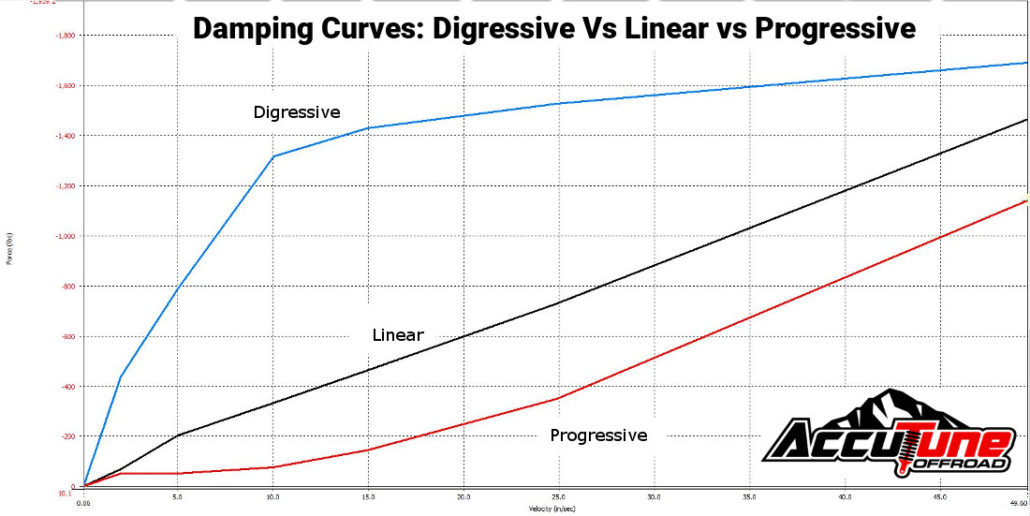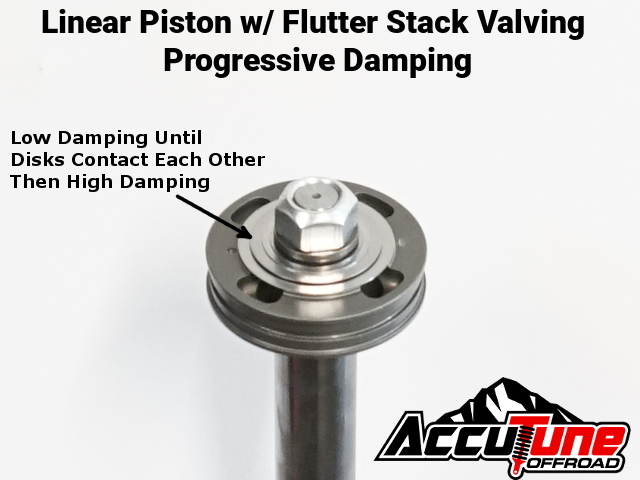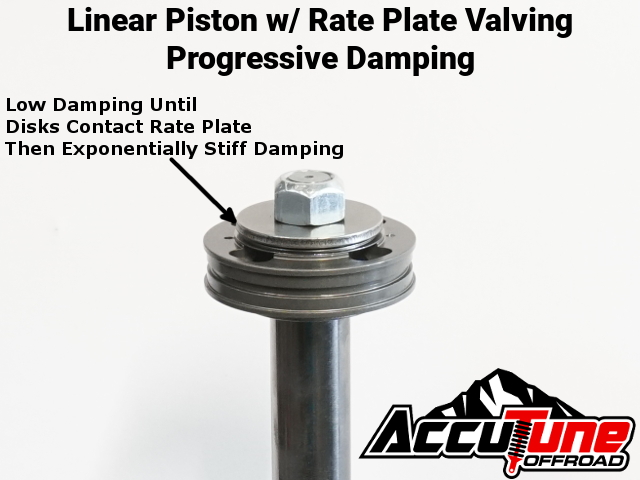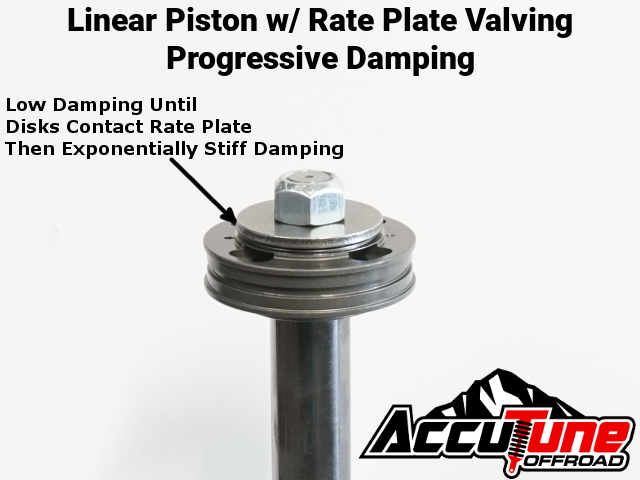Digressive vs Linear vs Progressive Pistons & Shock Valving
AccuTune Off-Road’s Experience:
Ryan Raker, the founder and author of this article, has been designing, tuning, and manufacturing shocks with digressive, linear, and progressive damping curves since 2001. Throughout this time, he has utilized cutting-edge shock dynos to design and tune high-end shocks for nearly every major lift kit manufacturer. This experience has given AccuTune Off-Road a deep understanding of the real-world advantages and disadvantages of each shock type, how to fine-tune them, and their ideal applications.
Performance of Digressive, Linear, and Progressive shocks:
Shocks can be digressive in compression, rebound, or both, and each configuration has its own set of pros and cons. The terms Digressive, Linear, and Progressive refer to the shape of the damping curve produced by a shock (as shown below). Most Fox Shocks and King Shocks are linear, while many Icon shocks and entry-level Bilstein models (5100 & 6100) are digressive. The graph below shows data directly from a shock dyno, used for illustrative purposes only.
If these were rebound loads, and the shocks were tuned for the same vehicle, they would likely intersect around 10 in/sec or less. For compression loads, they would probably intersect around 100 in/sec.
Shock design and tuning directly affect performance across various conditions—small bumps, washboard surfaces, large bumps, whoops, g-outs, and handling. The key to creating the perfect damping curve is finding the right balance to ensure optimal performance across all suspension events. In the examples below, it’s assumed each shock is well-designed and either very digressive or very progressive, in order to highlight the differences.
Small Bump & Washboard:
Small bumps and washboard surfaces cause the wheel to move very quickly, but with very small displacements. Due to the minimal movement, the valve disks in the shock may not have enough time to open properly. As a result, these forces typically occur around 2 to 10 in/sec for both compression and rebound. Looking at the graph, we can see that digressive pistons would likely feel stiff and possibly harsh, while progressive shocks would offer a much smoother ride. Since the movements are so small, factors like tire pressure and tire stiffness can have a significant impact on ride comfort.
Large Bumps & Whoops:
Large bumps and whoops are high-speed events that affect both compression and rebound, and it’s crucial to consider how both the chassis and the wheels respond.
During compression, the wheel can move at speeds exceeding 200 in/sec. Ideally, the shock will absorb the bump while also lifting the chassis to prevent bottoming out. A digressive shock may release too much load too quickly, failing to raise the chassis sufficiently. On the other hand, an extremely progressive shock will provide a smooth, controlled response, helping manage the impact.
On rebound, the wheel might move around 50 in/sec. A digressive shock will initially pull the chassis into the bumps, then allow the wheel to move freely once it reaches the right speed. However, with very digressive shocks, the abrupt change in stiffness can make the vehicle feel as if it’s losing control. A shock with a progressive rebound damping curve, in contrast, will create a sensation that the wheels and chassis are disconnected, which may result in a bouncier ride.
G-Outs, Towing and Overloading The Suspension:
On g-outs and other slow-speed bottoming events, digressive shock valving will feel firm and controlled, as it resists bottoming out and maintains stability. In contrast, progressive shock valving may feel out of control, as the suspension will bottom out more easily and then rebound quickly, leading to a less controlled and more jarring ride.
Handling:
Handling is a tricky aspect to manage. Digressive valving typically offers better handling than progressive valving due to the higher forces at 2 in/sec. While shocks and springs do influence handling, they should not be the primary factors for tuning it. Shocks and springs are the only tunable elements that control performance across different suspension events, so they should be tuned to provide the best possible ride quality. Handling, however, should primarily be addressed through the sway bar, as that is its main function.
Summary:
Digressive shocks struggle with both small bumps and large hits, but excel at handling and g-outs. Progressive shocks, on the other hand, are great for small bumps and big hits but fall short in handling and g-outs. Linear shocks offer the best all-around performance.
At AccuTune Off-Road, we design the shape of the shock curve to match the performance you need for the type of terrain you’ll be driving on. The result is curves that are slightly digressive, linear, or slightly progressive—delivering the benefits of each type without the associated drawbacks.
[layerslider id=”13″]
Piston & Shock Designs For Digressive, Linear and Progressive Damping Performance:
There are two traditional piston designs: Digressive and Linear. Digressive pistons primarily produce digressive shock curves (as the name suggests), while linear pistons are more versatile and can produce digressive, linear, or progressive shock curves, depending on how they’re tuned.
Digressive Piston Design:
Digressive shocks are created by preloading the valve disks, typically between 0.002″ and 0.015″. The most common method for achieving this is by designing the piston with a raised outer edge where the piston seals. While some shocks clearly feature a raised edge, others have a more subtle convex shape that’s less noticeable. The downside of these designs is that even slight variations in preload thickness can result in significant differences in damping loads, affecting consistency.
Linear Piston Design For Digressive Performance:
Linear pistons have perfectly flat faces, so different techniques are required to create a digressive damping curve. If the shock doesn’t need to be extremely digressive, a linear piston can be made digressive by using a very small through-bleed hole. This method is typically effective for shocks that have a lot of rebound damping, as it helps control the flow and achieve the desired damping characteristics.
Linear pistons can be used to create digressive damping curves by preloading the valve disks. This can be achieved by using coil springs (often found in through-shaft compression adjusters) or by inserting a preload ring into the disk stack. In either case, the result is the same: the preload alters the shock’s damping behavior, allowing it to produce a digressive curve.
Linear Piston Design For Linear Performance:
Shock pistons with a flat sealing surface for the disks and a sufficient bleed hole size will produce a linear shock curve. However, even linear shocks typically exhibit a slight “nose” or point on the curve around 2 in/sec. This is due to friction and other forces associated with the transition of internal parts from stationary to moving (or when reversing direction).
For achieving linear performance, it’s most common to use pyramid stacks—a stack of valve disks with decreasing diameters, as shown below. However, it is also possible to achieve linear performance using a flutter stack, though this is less typical.
[layerslider id=”13″]
Linear Piston Design For Progressive Performance:
There are many ways to tune linear pistons to create progressive damping curves. These designs all allow for a significant amount of oil to flow unrestricted at slow speeds, but some techniques are more effective than others. Below, we’ve listed these methods in order from best to worst design.
Internal & External Bypass Shocks:
Internal and external bypass shocks feature additional flow paths that allow large amounts of oil to flow relatively unrestricted. Since this free flow is limited to certain parts of the shock’s travel, it helps address performance issues on g-outs by firming up towards the end of the travel. The best-designed bypass shocks have multiple stages, ensuring the transition from soft to firm occurs closer to the ride height and over a longer distance. This gradual shift prevents the shock from suddenly becoming too stiff, offering a smoother and more controlled ride.
Directional Bleed:
Bilstein produces a 46mm shock that incorporates a check valve to allow additional free bleed in the compression direction. This design enables the shock to create progressive damping curves on the compression side, where progressive damping is most commonly desired. This technique enhances the shock’s ability to handle varying terrain by providing a smoother, more controlled response in compression.
Flutter Stack Valving:
Flutter stack valving works similarly to directional bleed and is one of the most versatile methods for converting linear pistons into progressive damping curves. Due to their design, flutter stacks can be added to any existing linear piston to achieve the precise shock curve you want. After years of field testing and dyno testing, we have perfected the use of flutter stack valving to deliver consistent and optimal performance across a wide range of applications.
Soft Piston Valving With A Rate Plate:
A rate plate works by incorporating soft initial valving that eventually hits a stiff plate, which prevents the valve disks from continuing to deflect. As a result, the main valving behaves like an orifice, progressively building exponentially more force. While this design can be effective, it requires extensive tuning and testing to ensure that it doesn’t become harsh or overly stiff during operation. With the right adjustments, rate plates can provide a smooth, progressive damping curve while maintaining comfort and control.
Pistons With A Lot of Free Bleed:
By drilling multiple free bleed holes in the main shock piston, the damping curve can be made progressive. At slow speeds, oil flows freely through the large holes, providing minimal resistance. As the speed increases, the holes reach their maximum flow rates, and the main piston valving begins to engage, making the shock stiffer on the high end. While this design effectively makes both compression and rebound progressive, it’s not always ideal, as it can lead to undesirable performance characteristics in certain situations. For instance, having both compression and rebound be progressive can create a less predictable or more bouncy ride.
Step Off Disks:
The final method for making a linear piston progressive involves inserting a thin, small-diameter disk against the piston. This allows oil to flow freely before the main disks begin to deflect. While this method can create a progressive curve, it results in inconsistent damping on both sides of the piston, leading to uneven performance. As a result, this approach should generally be avoided, although it is unfortunately still seen in some shock designs. The inconsistency can negatively impact the overall performance and ride quality.
Summary:
There are many options for piston design and damping curve configurations, but anything too extreme often leads to undesirable performance in traditional off-road shocks. Digressive pistons can be beneficial for on-road use or for those who don’t mind a rougher ride. Linear pistons with progressive damping curves can offer an exceptional ride when tuned properly, with good bottoming control. Linear damping curves generally provide the best all-around performance in standard designs. No matter what you choose, AccuTune Off-Road will fine-tune the damping curve to deliver the performance you’re looking for.

























You are the only site I found with clear explanations about the differences between shocks/struts. These videos and write ups are extremely appreciated!
Awesome, thank you for the kind words. Glad this article could help!